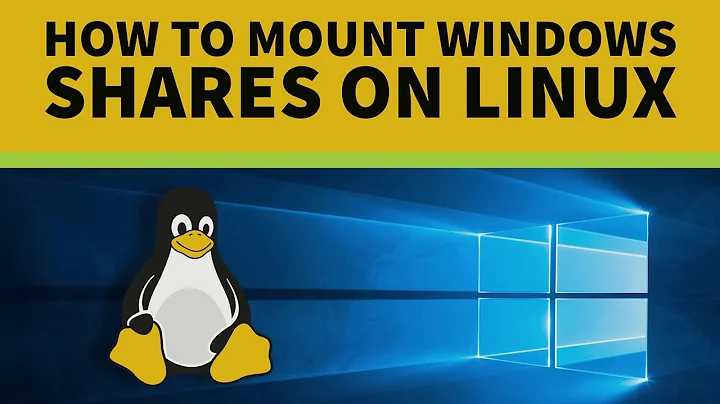Mounting a Windows folder with writing permissions in Ubuntu
Solution 1
The above linked super user question is for mounting partition and sub directory in read only mode. You need only the sub-directory (personal folder) to be read-write.
First check your system can mount ntfs partition in read-write mode
mount -t ntfs-3g -o rw /dev/sda1 /media/windows
Now test if the mounted fs is writable. If not stop here and ask another question in this site.
The problem is an RO mounted partition's sub-directory can't be in RW. So the solution is mount the windows partition in RW in a hidden and inaccessible place. So let's mount it on /root/win which is inaccessible by non-root users (without sudo)
As a root user do following
Steps
1. Mount windows partition in RW
mount -t ntfs-3g -o rw /dev/sda1 /root/win
2. Bind it
mount --bind /root/win/Users/MyUser/ /home/myuser/Windows
3. Bind a read only instance of windows partition
mount --bind /root/win /media/windows
mount -o remount,ro /media/windows
Now everything should be OK. Additionally you can unmount the windows partition but I warn you in some system it will make make the binded one (@home) inaccessible. The code is umount /root/win
Alternatively you can mount the windows partition in RW at /media/windows ( instead of /root/win) and immediately bind mount it at the same mount point (/media/windows) so that no one (even root) can write on the partition (but on the user folder).
Solution 2
I doubt that the linked superuser answer is a working one. (Though I can't try it.) From man mount:
Note that the filesystem mount options will remain the same as those on the original mount point, and cannot be changed by passing the -o option along with --bind/--rbind. The mount options can be changed by a separate remount command, for example:
mount --bind olddir newdir
mount -o remount,ro newdir
I also doubt that it is possible to --rbind a part of a file system with a different file system driver (ntfs vs ntfs-3g).
When you rbind the mount command ignores every option, so nothing will become read-write. And because the kernel ntfs driver does not support writes, obviously the rw option won't help with that one either. Use the ntfs-3g driver.
Basically what you should do is this (in a terminal):
mount -t ntfs-3g -o ro /dev/sda1 /media/windows
mount --bind /media/windows/Users/MyUser/ /home/myuser/Windows
mount -o remount,rw /home/myuser/Windows
(I think that --rbind is also unnecessary, --bind should be enough.)
And regarding the comment under the question: Of course you don't have to restart the system for testing, just use the mount command as I did above. (And unmount with the umount command.)
After you confirmed that this works as intended, you just modify the mount and add the options you want: uid, gid,umask, etc.
Solution 3
See if this helps...
If sda1 is already mounted to /media/windows, you could unmount it with:
sudo umount /media/windows
Next create the directory windows in /media/:
sudo mkdir /media/windows
Edit the /etc/fstab as below:
/dev/sda1 /media/windows ntfs-3g rw,nodev,noexec,auto,nouser,async,locale=en_US.utf8,uid=1000,gid=1000,umask=0002 0 0
/media/windows/Users/MyUser/ /home/myuser/Windows ntfs-3g rbind,user,rw,nodev,noexec,auto,async,uid=1000,gid=1000,umask=0002 0 0
/media/windows/Users/OtherUser/ /home/otheruser/Windows rbind,user,rw,nodev,noexec,auto,async,uid=1001,gid=1001,umask=0002 0 0
(Note: change uid and gid values as for the user. To get the uid and gid of a user you can use the command id -u username and id -g username resp.)
Now you can mount these with the command:
sudo mount -a
Now go to the rebinded directories and see if you can edit the file. And you should be done.
Solution 4
Do all your testing before editing your fstab configuration file.
Well, you probably know that ntfs filesystem is automatically mounted in read-only if filessystem is flagged as dirty. What you have to do first before trying any of the answers is to mount disk in windows and run chkdsk before trying to mount it again.
Also, if mounting in rw still failing, you should try mounting with different mount type options such as sudo mount -t ntfs or sudo mount -t ntfs-3g
Once fs is mounted in rw you can do the following :
mount --bind /media/MOUNTPOINT/TARGETFOLDER /home/SHAREDDIRECTORY/
mount -o remount,ro /home/SHAREDDIRECTORY/
or
sudo gksu nautilus or sudo gksu dolphin to open an explorer with su rights
Solution 5
I am not quite sure however, can you try this please. After the drive is mounted, give the following command on the terminal
sudo gksu nautilus
enter your administrative password and in the graphical window that open, you should be able to click the drive and change read/write permissions.
Let me know if this works. There is help available for use of nautilus with graphical interface with root privileges.
Related videos on Youtube
Carlos Eugenio Thompson Pinzón
Updated on September 18, 2022Comments
-
Carlos Eugenio Thompson Pinzón over 1 year
Apparently the answer is here: https://superuser.com/questions/251537/mount-specific-ntfs-directory-on-linux however it is not working as expected.
I have a dual boot system with Windows 7 and Ubuntu 13.04 (upgraded from 12.10), and I want to access my Windows 7 personal folders for both reading and writing. I followed instructions according to the given link and my
/etc/fstabfile looks like this:/dev/sda1 /media/windows ntfs ro,umask=0222,defaults 0 0 /media/windows/Users/MyUser/ /home/myuser/Windows ntfs-3g rbind,user,umask=0222,defaults 0 0 /media/windows/Users/OtherUser/ /home/otheruser/Windows ntfs-3g rbind,user,umask=0222,defaults 0 0It almost works as expected. My Windows partition is on
/media/windows/with read-only permissions and my Windows personal folder is in~/Windows. However this personal folder is also read-only.Note I'm configuring this in a multisession environment, so I need this to work for my session and for other user's sessions. I need that each user can access and be able to write and read their Windows folders from Linux.
-
Carlos Eugenio Thompson Pinzón over 10 yearsIs there any way I can change and test configurations without having to restart the whole system. So far I have tried changing umask (to 0002), adding uid and gid parameters, etc. with no positive results, but each change requires a system shutdown.
-
Carlos Eugenio Thompson Pinzón over 10 yearsI had awarded the 100 bounty to totti for the idea or mounting the partition under
/root/(which is working). My current solution uses the hints provided by falconer, ajThapa, totti and yilmi, none of them is working as expected in the original question (protections are not enough), but it is working (users have rw access to their data). All these mentioned answers were upvoted.
-
-
Carlos Eugenio Thompson Pinzón over 10 yearsI can neither change permission or owner (even with
sudo). It rejects the command saying that the system is read-only. Not even in/media/windows/which is the whole partition (and which would not be the expected behavior) -
Carlos Eugenio Thompson Pinzón over 10 yearsI will check, however I would rather have the whole partition read-only and only some specific folders as read-write.
-
Carlos Eugenio Thompson Pinzón over 10 yearsDidn't work. Both the partition and the folders are still read-only. The only difference is that chmod and chown do not fail reporting a read-only error: they just don't operate.
-
 virtualxtc over 10 yearsI'm probably wrong, but sometimes sudo doesn't have permissions that root would have. Try running sudo su then chmod
virtualxtc over 10 yearsI'm probably wrong, but sometimes sudo doesn't have permissions that root would have. Try running sudo su then chmod -
 Wilf over 10 yearsThis would allow access to the files and they could be copied off as well, but the read-only permissions might not be changed, as non-unix filesystems are mounted as read only...
Wilf over 10 yearsThis would allow access to the files and they could be copied off as well, but the read-only permissions might not be changed, as non-unix filesystems are mounted as read only... -
 totti over 10 yearsDoes it work ? What the problem?
totti over 10 yearsDoes it work ? What the problem? -
Carlos Eugenio Thompson Pinzón over 10 yearsThe first part, mounting rw in /media/windows seems to work although it does not report w permissions I can actually touch and edit files.
-
Carlos Eugenio Thompson Pinzón over 10 yearsOkay, I have rw permissions on
/media/windows(not reported inls, but I can edit files) as root, however in the local directories I need tosudoin order to modify the files. -
Carlos Eugenio Thompson Pinzón over 10 yearsThank you for the
chkdsk. There was indeed some corruptions in the NTFS partition, and now I can write to the mounted drive withsudo. -
Carlos Eugenio Thompson Pinzón over 10 yearsWell, I can test using
mount, however when I find the working configuration, I will want to do it automatically, either by/etc/fstabor by any other means. (With the Ob Question: how do I translatemountcommands intofstabparameters?) -
falconer over 10 years@CarlosEugenioThompsonPinzón The
fstabis just a file which is parsed sequentially by themountcommand on startup. But I think Ubuntu doesn't usemountbutmountallat startup, which may not run the commands in fstab sequentially. So yes, putting these command parameters simply tofstabmight not work. But you can always put simply the working mount commands into a startup script (e.g/etc/rc.local) or make an upstart job from those. The more important thing in your case is to find out a working mount scheme, making it automount on startup is an easy job. -
Carlos Eugenio Thompson Pinzón over 10 years... and now all mounted directories are belonging to me (user 1000), from
/media/windowsto/home/someotheruser/Windows. -
Carlos Eugenio Thompson Pinzón over 10 yearsWhen remounting I get the following error:
Remounting is not supported at present. You have to umount volume and then mount it once again. -
precise over 10 yearsI guess now you and other users can make and save works in the resp. mount-points in the users' $HOME... if the rest of users still aren't able to have RW access, add them to your group (probably with the gid 1000)
-
falconer over 10 years@CarlosEugenioThompsonPinzón Oops I missed the last question from you comment. So how the mount commands translate to fstab? You can look it up in
man mountor here. Short story: first field: device to mount, second field: mount point, third field: fs-type (more precisely fs driver), fourth field: mount options, the other field are less importat now. So form the mount command the string we wrote behind-tgoes in the third field, the string we wrote behind-ogoes into the fourth field. -
 totti over 10 yearsI think its your system's problem. I have this tested successfully in ubuntu 12.10. I never see such error even in ubuntu 10.04. You may try it in a live system(as you seemed to be updated the OS).
totti over 10 yearsI think its your system's problem. I have this tested successfully in ubuntu 12.10. I never see such error even in ubuntu 10.04. You may try it in a live system(as you seemed to be updated the OS). -
Carlos Eugenio Thompson Pinzón over 10 yearsCurrently I have a group to which all local users are attached, and I'm granting write permissions to that group. This solves the “each user has rw access to their own data” but the whole partition and other user's data is not protected.
-
Bill The Ape over 9 yearsThanks +1 from me, too, for an elegant solution and a very clear explanation. I especially like the trick for mounting the user folder so that one one (even root) can write on other than the user folder. That is indeed the best solution as no OS instance other than the Windows 8.1 instance to which system files belong has any business accessing those system files. Shared data, however, is a different story.




